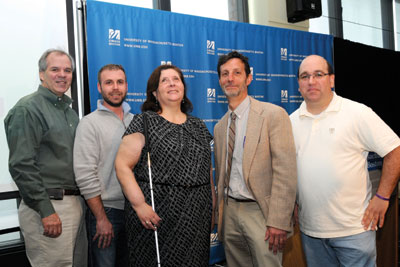University of Massachusetts Boston
Three years ago, a deaf and blind student registered for online business courses at the University of Massachusetts Boston. In order to arrange the necessary services for the student, Valerie Claire Haven, academic technology coordinator for the Ross Center for Disability Services, made what she thought would be a routine phone call to her captioning vendor, Caption First. She was stunned when the vendor explained that there was no way to transmit the captioning over the internet so that a deaf and blind person would be able to access it.

The U Mass team (left to right): John Jessoe, Zack Ronald, Valerie Claire Haven, Alan Girelli, and Jeff Wade |
Nevertheless, Haven was undaunted. "If I come up with something, would you be willing to look at it?" she asked. Caption First was happy to comply.
So Haven and the UMB team set out to create a toolkit that would enable hearing- and sight-impaired students to participate fully in classes. The team's first goal was to meet the needs of the deaf and blind student who had just enrolled in three business courses, as well as those of a deaf student who was working toward her graduate degree in counseling.
One of the business classes--a course in business management--required all students to listen and respond to class conversations that took place in Wimba Classroom (now Blackboard Collaborate) virtual sessions. To enable the deaf and blind student to participate, a professional caption writer transcribed the live dialogue and sent the captions to both a Jaws screen reader (from Freedom Scientific) and a Braille keyboard, via a combination of Wimba Classroom and Serotek's Accessible Event synchronous conferencing tool.
The setup allowed the deaf and blind student to "hear" the classroom text chat by reading the dialogue on the Braille keyboard with her fingertips. (A Braille keyboard is similar to a traditional keyboard but with an additional row under the space bar for reading Braille output.)
The second project, for the deaf and sighted student in a graduate-level counseling course, launched in September 2010. For this class, students had to review videotaped counseling sessions. Confidentiality laws, however, prohibited the use of an in-class professional signer to translate the sensitive content. To get around this, UMB contracted a professional caption writer to listen remotely--by telephone--to the video's audio track, and then stream captions back to the classroom. An encoder/decoder system provided by the Media Access Group at WGBH--a Boston-based public television company--streamed the captions onto a projection screen, where they appeared under the video. WGBH is the first station in the country to caption video for the deaf and audio-describe video for the blind, says Haven.
This setup also enabled UMB to avoid conflict with copyright laws governing visual media. "Copyright laws are a nightmare from an accessibility standpoint," Haven explains. While there's considerable federal law about making print media accessible to people with disabilities, there's not as much law about visual media. Captioning a video often requires multiple levels of copyright permission. "We solved that whole thing because the caption was showing independently from the video--it appeared underneath it," notes Haven.
Besides providing a way for the sight- and hearing-impaired students to receive course content, the toolkits enabled them to fully participate in their classes, something they hadn't been able to do before. After the first clinical video was live-captioned during class, for instance, the deaf student reported that it was the first time she had ever felt fully included in a course meeting.
And when the instructor for the business-management course first called on the deaf and blind student to comment, the class--expecting that captions sent through a second conferencing tool would rebroadcast to her Braille keyboard 10-12 seconds later--waited for her delayed response. Thanks to the speed of the live-captioning system, the class let out a collective gasp when the student vocalized her response just six seconds later. The tool suite worked so well that Caption First is now offering it as a service.
Sighted students have benefited as well: They report that the captions help them understand the course content better.
Haven's tireless pursuit of the toolkit has a personal motivation: "I'm blind," she notes." A big reason why this project went as easily as it did was because I understood, firsthand, what these students were going through."
About the Author
Kanoe Namahoe is online editor for 1105 Media's Education Group. She can be reached at [email protected].